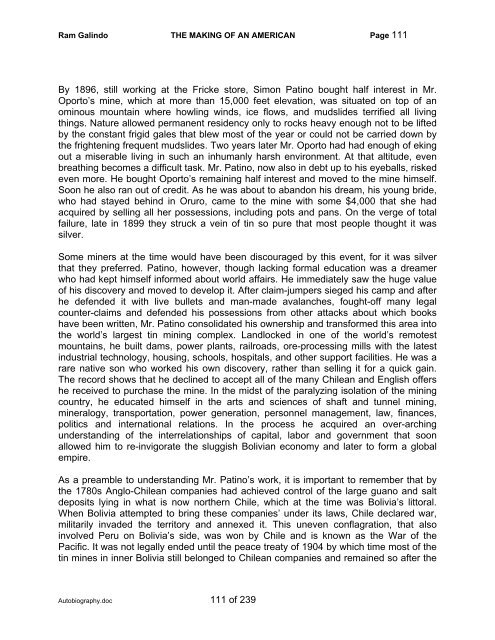Autobiography - The Galindo Group
Autobiography - The Galindo Group
Autobiography - The Galindo Group
Create successful ePaper yourself
Turn your PDF publications into a flip-book with our unique Google optimized e-Paper software.
Ram <strong>Galindo</strong> THE MAKING OF AN AMERICAN Page 111<br />
By 1896, still working at the Fricke store, Simon Patino bought half interest in Mr.<br />
Oporto’s mine, which at more than 15,000 feet elevation, was situated on top of an<br />
ominous mountain where howling winds, ice flows, and mudslides terrified all living<br />
things. Nature allowed permanent residency only to rocks heavy enough not to be lifted<br />
by the constant frigid gales that blew most of the year or could not be carried down by<br />
the frightening frequent mudslides. Two years later Mr. Oporto had had enough of eking<br />
out a miserable living in such an inhumanly harsh environment. At that altitude, even<br />
breathing becomes a difficult task. Mr. Patino, now also in debt up to his eyeballs, risked<br />
even more. He bought Oporto’s remaining half interest and moved to the mine himself.<br />
Soon he also ran out of credit. As he was about to abandon his dream, his young bride,<br />
who had stayed behind in Oruro, came to the mine with some $4,000 that she had<br />
acquired by selling all her possessions, including pots and pans. On the verge of total<br />
failure, late in 1899 they struck a vein of tin so pure that most people thought it was<br />
silver.<br />
Some miners at the time would have been discouraged by this event, for it was silver<br />
that they preferred. Patino, however, though lacking formal education was a dreamer<br />
who had kept himself informed about world affairs. He immediately saw the huge value<br />
of his discovery and moved to develop it. After claim-jumpers sieged his camp and after<br />
he defended it with live bullets and man-made avalanches, fought-off many legal<br />
counter-claims and defended his possessions from other attacks about which books<br />
have been written, Mr. Patino consolidated his ownership and transformed this area into<br />
the world’s largest tin mining complex. Landlocked in one of the world’s remotest<br />
mountains, he built dams, power plants, railroads, ore-processing mills with the latest<br />
industrial technology, housing, schools, hospitals, and other support facilities. He was a<br />
rare native son who worked his own discovery, rather than selling it for a quick gain.<br />
<strong>The</strong> record shows that he declined to accept all of the many Chilean and English offers<br />
he received to purchase the mine. In the midst of the paralyzing isolation of the mining<br />
country, he educated himself in the arts and sciences of shaft and tunnel mining,<br />
mineralogy, transportation, power generation, personnel management, law, finances,<br />
politics and international relations. In the process he acquired an over-arching<br />
understanding of the interrelationships of capital, labor and government that soon<br />
allowed him to re-invigorate the sluggish Bolivian economy and later to form a global<br />
empire.<br />
As a preamble to understanding Mr. Patino’s work, it is important to remember that by<br />
the 1780s Anglo-Chilean companies had achieved control of the large guano and salt<br />
deposits lying in what is now northern Chile, which at the time was Bolivia’s littoral.<br />
When Bolivia attempted to bring these companies’ under its laws, Chile declared war,<br />
militarily invaded the territory and annexed it. This uneven conflagration, that also<br />
involved Peru on Bolivia’s side, was won by Chile and is known as the War of the<br />
Pacific. It was not legally ended until the peace treaty of 1904 by which time most of the<br />
tin mines in inner Bolivia still belonged to Chilean companies and remained so after the<br />
<strong>Autobiography</strong>.doc 111 of 239


